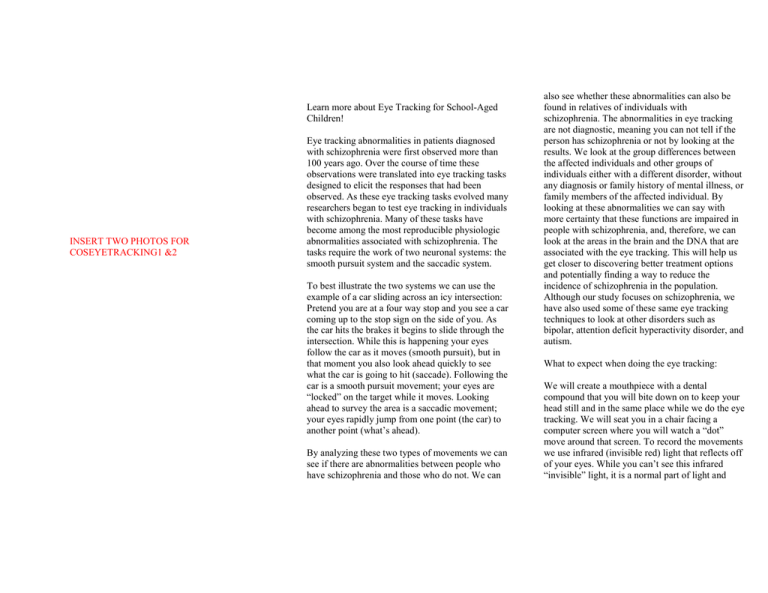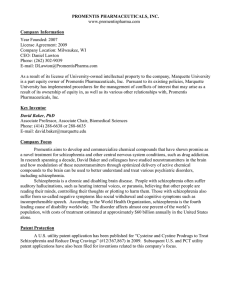also see whether these abnormalities can also be
advertisement

Learn more about Eye Tracking for School-Aged Children! INSERT TWO PHOTOS FOR COSEYETRACKING1 &2 Eye tracking abnormalities in patients diagnosed with schizophrenia were first observed more than 100 years ago. Over the course of time these observations were translated into eye tracking tasks designed to elicit the responses that had been observed. As these eye tracking tasks evolved many researchers began to test eye tracking in individuals with schizophrenia. Many of these tasks have become among the most reproducible physiologic abnormalities associated with schizophrenia. The tasks require the work of two neuronal systems: the smooth pursuit system and the saccadic system. To best illustrate the two systems we can use the example of a car sliding across an icy intersection: Pretend you are at a four way stop and you see a car coming up to the stop sign on the side of you. As the car hits the brakes it begins to slide through the intersection. While this is happening your eyes follow the car as it moves (smooth pursuit), but in that moment you also look ahead quickly to see what the car is going to hit (saccade). Following the car is a smooth pursuit movement; your eyes are “locked” on the target while it moves. Looking ahead to survey the area is a saccadic movement; your eyes rapidly jump from one point (the car) to another point (what’s ahead). By analyzing these two types of movements we can see if there are abnormalities between people who have schizophrenia and those who do not. We can also see whether these abnormalities can also be found in relatives of individuals with schizophrenia. The abnormalities in eye tracking are not diagnostic, meaning you can not tell if the person has schizophrenia or not by looking at the results. We look at the group differences between the affected individuals and other groups of individuals either with a different disorder, without any diagnosis or family history of mental illness, or family members of the affected individual. By looking at these abnormalities we can say with more certainty that these functions are impaired in people with schizophrenia, and, therefore, we can look at the areas in the brain and the DNA that are associated with the eye tracking. This will help us get closer to discovering better treatment options and potentially finding a way to reduce the incidence of schizophrenia in the population. Although our study focuses on schizophrenia, we have also used some of these same eye tracking techniques to look at other disorders such as bipolar, attention deficit hyperactivity disorder, and autism. What to expect when doing the eye tracking: We will create a mouthpiece with a dental compound that you will bite down on to keep your head still and in the same place while we do the eye tracking. We will seat you in a chair facing a computer screen where you will watch a “dot” move around that screen. To record the movements we use infrared (invisible red) light that reflects off of your eyes. While you can’t see this infrared “invisible” light, it is a normal part of light and won’t hurt your eyes. The reflections of this infrared light are then picked up by sensors and translated into the movements that we then analyze. INSERT COS EYETRACKING DEMONSTRATION HERE The visual smooth pursuit task that the subjects see is very similar to this crude demonstration.


